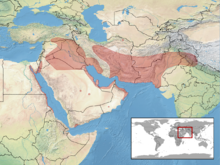Cyrtopodion scabrum
| Cyrtopodion scabrum | |
|---|---|

| |
| Scientific classification | |
| Domain: | Eukaryota |
| Kingdom: | Animalia |
| Phylum: | Chordata |
| Class: | Reptilia |
| Order: | Squamata |
| Family: | Gekkonidae |
| Genus: | Cyrtopodion |
| Species: | C. scabrum
|
| Binomial name | |
| Cyrtopodion scabrum (Heyden, 1827)
| |

| |
| Synonyms[2] | |
Cyrtopodion scabrum, also known as the rough-tailed gecko, rough bent-toed gecko, rough-tailed bowfoot gecko, common tuberculate ground gecko, or keeled gecko, is a species of gecko, a lizard in the family Gekkonidae. The species is endemic to Asia.
Taxonomy[edit]
Cyrtopodion basoglui is considered conspecific with Cyrtopodion scabrum. Because Cyrtopodion scabrum was originally described in 1827 and Cyrtodactylus basoglui was described in 1982, Cyrtodactylus basoglui is a junior synonym of Cyrtopodion scabrum.
Geographic range[edit]
C. scabrum is found in Afghanistan, Djibouti,[3] Egypt[4] (Siwa Oasis: HR 31: 254), Eritrea, Ethiopia, India, Iran, Iraq, Israel, Jordan, Kuwait, Oman, Pakistan, Qatar, Saudi Arabia, Sinai/Tor, Sudan, Turkey, Greece, United Arab Emirates, and the USA (introduced to Texas and Arizona).[2]
As an introduced species[edit]
In the United States, C. scabrum has been introduced in Arizona and Texas. A breeding population has been established in Galveston, Texas, in the area of the commercial shipping docks.[5]
References[edit]
- ^ Els, J.; Al Johany, A.M.H.; Amr, Z.S.S.; Nilson, G.; Sevinç, M.; Tok, C.V.; Werner, Y.L.; Disi, A.M.; Ugurtas, I.H.; Baha El Din, S.; Papenfuss, T. (2021). "Cyrtopodion scabrum". IUCN Red List of Threatened Species. 2021: e.T164748A1072727. doi:10.2305/IUCN.UK.2021-3.RLTS.T164748A1072727.en. Retrieved 21 February 2022.
- ^ a b "Cyrtopodion scabrum ". The Reptile Database. www.reptile-database.org.
- ^ "Keeled Rock Gecko (Cyrtopodion scabrum)".
- ^ Din, Sherif Baha El (2006). A guide to reptiles and amphibians of Egypt. Cairo, Egypt. ISBN 978-1-61797-517-2. OCLC 880445081.
{{cite book}}: CS1 maint: location missing publisher (link) - ^ Powell R, Conant R, Collins JT (2016). Peterson Field Guide to Reptiles and Amphibians of Eastern and Central North America, Fourth Edition. Boston and New York: Houghton Mifflin Harcourt. xiv + 494 pp., 47 plates, 207 figures. ISBN 978-0-544-12997-9. (Cyrtopodion scabrum, p. 259 + Plate 23).
Further reading[edit]
- Boulenger GA (1885). Catalogue of the Lizards in the British Museum (Natural History). Second Edition. Volume I. Geckonidæ, Eublepharidæ, Uroplatidæ, Pygopodidæ, Agamidæ. London: Trustees of the British Museum (Natural History). (Taylor and Francis, printers). xii + 436 pp. + Plates I-XXXII. (Gymnodactylus scaber, pp. 27–28).
- Das I (2002). A Photographic Guide to Snakes and other Reptiles of India. Sanibel Island, Florida: Ralph Curtis Books. 144 pp. ISBN 0-88359-056-5. (Cyrtopodion scabrum, p. 92).
- Heyden CHG von (1827). "Reptilien ". pp. 1-24. In: Rüppell E. Atlas zur der Reise im nördlichen Afrika. Erste Abtheilung, Zoologie. Frankfurt am Main: H.L. Brönner. 622 pp. (Stenodactylus scaber, new species, pp. 15-17 + Plate 4, figure 2). (in German and Latin).
- Rösler, Herbert (2000). "Die postanale Beschuppung bei Cyrtodactylus Gray 1827 und Cyrtopodion Fitzinger 1843 - funktionelle und taxonomische Aspekte (Sauria: Gekkonidae)". Gekkota 2: 154–207. (in German).
External links[edit]

